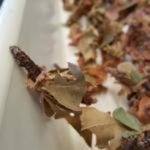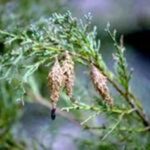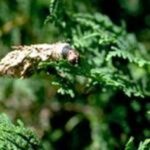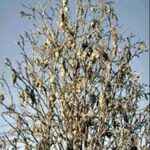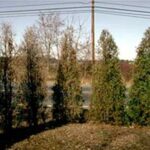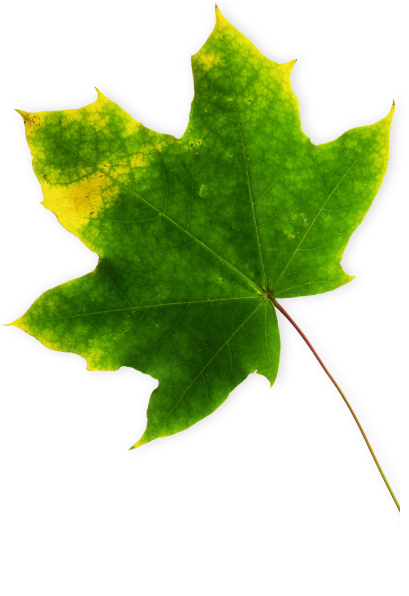Bagworm (Thyridopteryx ephemeraeformis) is native to North America. It is distributed throughout the eastern United States. Once only an occasional pest in Massachusetts, is becoming a regular problem in the landscape. Historically, bagworms are only a continuous problem from Maryland and south. New populations may be brought in on nursery stock from more southern states and introduced into the landscape at planting time. Because this insect does not pupate until late September into October it is usually killed by frost in New England. Mild fall and winter temperatures have allowed bagworms to successfully overwinter and established populations locally.
The Bagworm’s Identity
Bagworms are a species of caterpillar in the same family as winter moth and spongy moth (AKA gypsy moth). They are easily recognizable by the protective bags they construct from silk and plant material, which they carry around as portable homes. The appearance of the bag will vary depending on the plant species they are feeding on. These bags serve as both shelter and camouflage, making bagworms hard to spot until their numbers have multiplied.
Life Cycle of Bagworms
Understanding the life cycle of bagworms is crucial for effective management. In Massachusetts, bagworms typically have one generation per year. Their life cycle can be broken down into several stages:
- Egg Stage: Bagworm moths lay their eggs in the fall, securing them within their silk bags. These bags often look like small, brownish pods attached to twigs or foliage.
- Larval Stage: The eggs hatch in late spring or early summer, and the tiny larvae emerge. They immediately start constructing their protective bags and begin feeding on the surrounding plant material.
- Pupal Stage: As the larvae grow, they periodically abandon their old bags to create larger ones to accommodate their increasing size. When fully developed, they pupate inside their bags, undergoing metamorphosis into adult moths.
- Adult Stage: Adult bagworm moths are rarely noticed or seen as the females are wingless, don’t leave their bag and do not feed. Their sole purpose is to mate and lay eggs, continuing the cycle.
Damage Caused by Bagworms
Bagworms can be highly destructive pests. Arborvitae and juniper are the two most common hosts for this pest. However, they can feed on over 120 species of trees and shrubs (both deciduous and evergreen) including cedar, pine, sycamore, maple, locust, boxelder, and linden Their feeding behavior involves chewing leaves, and if infestations are severe, they can defoliate entire plants, leading to weakened, stressed, or even dead vegetation. This damage can be particularly concerning for gardeners and landscapers who invest time and effort in maintaining lush greenery.
Control and Management
Managing bagworm infestations in Massachusetts requires a multi-pronged approach. Here are some effective strategies to consider:
- Handpicking: For small infestations, physically removing the bags from the affected plants can be an effective control method. Be sure to destroy the bags to prevent the larvae from reinfesting the area.
- Biological Control: Beneficial insects, such as parasitic wasps and predatory beetles, can help control bagworm populations. Because Massachusetts is outside of the historic range beneficial parasitoids may be limited. Encourage these natural predators by planting a diverse range of plants.
- Chemical Control: Treatments can be made throughout the year to both control and prevent infestations. To be most effective, control measures should be implemented early in the bagworms’ life cycle, preferably when they are in their larval stage before they construct their bags.
- Monitoring: Regularly inspect your plants for signs of bagworm infestations. Early detection can make control efforts more successful.
Bagworms in Massachusetts can be a formidable adversary for gardeners and landscapers, but with a proper understanding of their life cycle and effective control strategies, we can protect your green spaces from their destructive tendencies. Whether through manual removal, biological control, or targeted chemical treatments, taking action against bagworms is essential for maintaining the health and beauty of your landscape. Contact us if you think you have this pest so one of our arborists can make a plan for treatment. For additional reading topics, please visit our blog!
